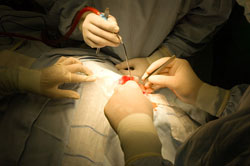Computer assisted design of hip replacement prostheses
The choice of either natural or synthetic biomaterials has made possible bone and joint replacement now in current use. Such implanted prostheses provide restored mobility and relief from suffering for thousands of patients; they are however still generally based on materials selected from engineering practice. Combining the ability to be tolerated by the human body with mechanical properties sufficient to withstand anticipated physiological stress, they offer an effective immediate solution. The European project BIOGRAD demonstrated the use of functionally graded ceramics to improve long-term performance, while reducing stress on hip joint replacements. With the variation of the composition from a tough zirconia-rich core to a hard, chemically and wear-resistant surface layer of alumina, a unique combination of properties could be offered. The particular interest in these materials is mostly due to the high hardness and chemical resistance of alumina, which is too brittle for many structural applications. On the other hand, zirconia is one of the toughest ceramic materials, which however does not retain its excellent mechanical properties in the presence of water and high temperature. To compensate for the tendency of ceramics to fail suddenly with local plastic deformation, project partners from Italy sought to identify the optimum conical coupling between stem and femoral head. Finite element methods were used to investigate the effects of changing parameters, such as material properties and contact geometry, on the surface shear stresses evolution within the ceramic femoral head. These numerical analyses incorporate the principles of Newtonian mechanics. They are applied to model and animate the realistic behaviour of the femoral head coupled with the prosthetic acetabular component in the patient's pelvis. Residual stresses developed in different parts of the fully graded ceramic structure were implemented into subsequent processes of the grinding and assembly to simulate the entire manufacturing cycle. The results indicated the importance of fixation between the head and the stem to withstand torque likely to be transmitted through the prosthesis in use. Specific definitions of the functionally graded materials' operating conditions will contribute in the future to superior mechanical properties and better wear resistance for prosthesis components.

